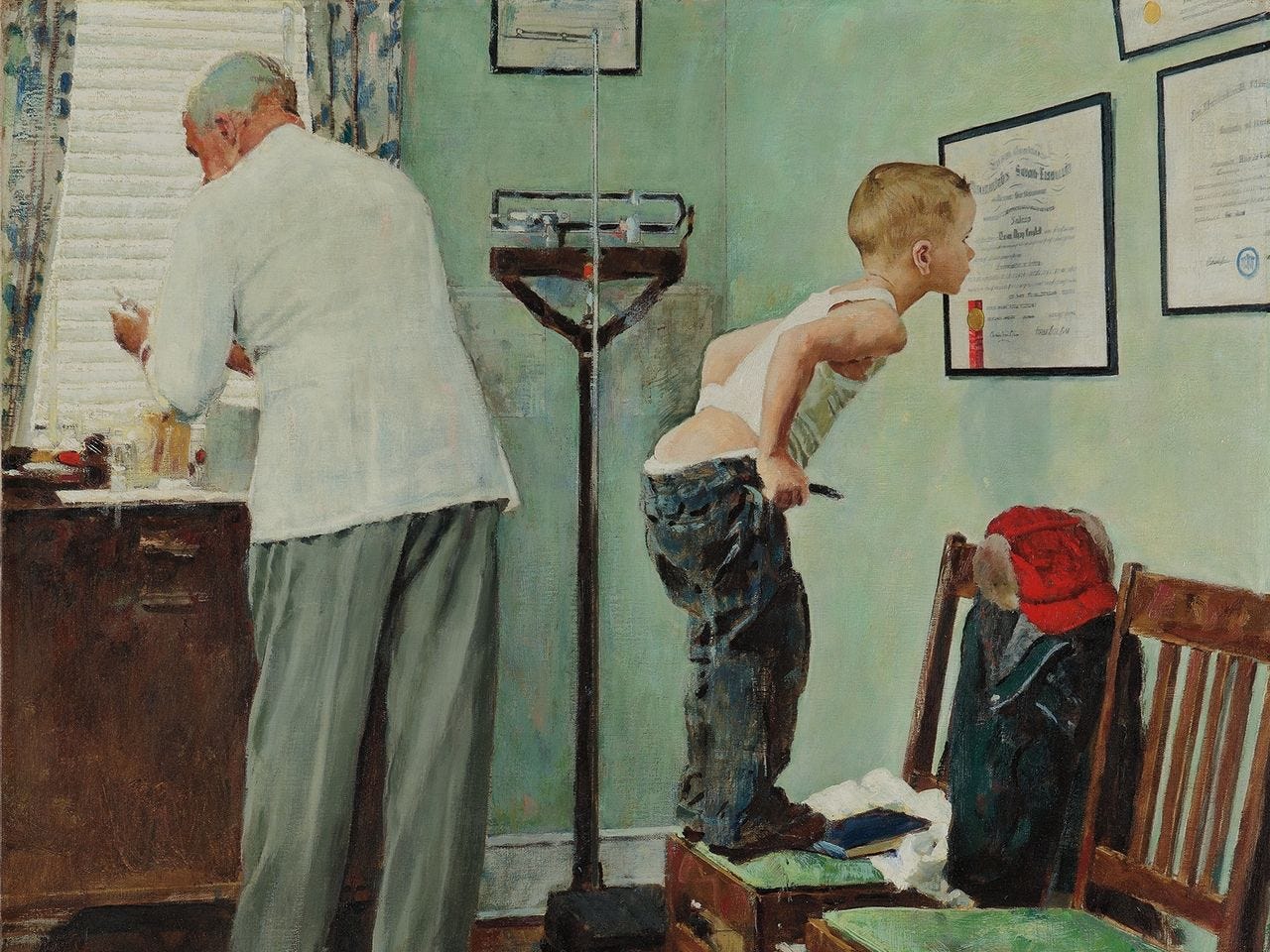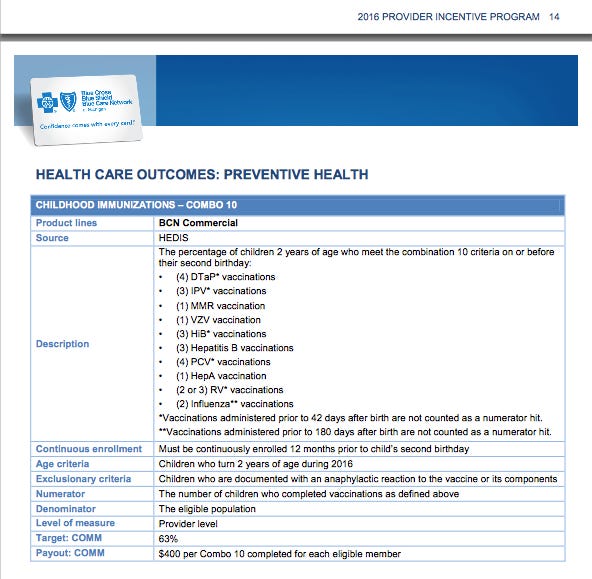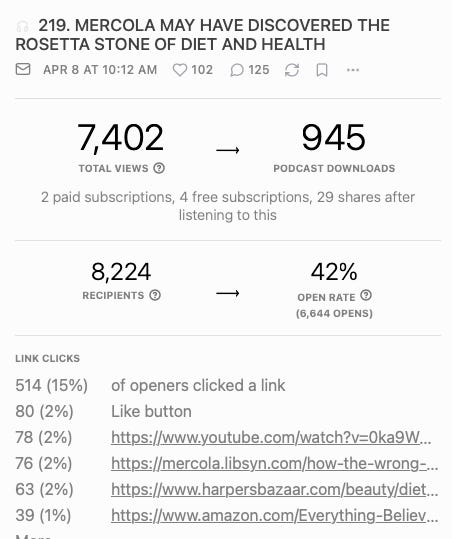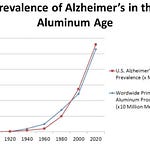Yoho note: I always regarded pediatricians as idealists who made little money and were unconnected with all the scams in medicine. While this may have been right 20 years ago, it is wrong today, for childhood vaccines are a disaster. Like the entire psych drug formulary, none of them have been studied against placebo (inactive) controls. Instead, vaccines have all been compared to other toxic vaccines or their supposedly "inactive" contents. This supported the lie that they were safe. What it actually showed was that newer ones were about the same as other dangerous but already "approved" injectables.
We know what these jabs do. Tens of thousands of kids have died in the first day to week after one of these injections, and tens of thousands more stopped speaking, started banging their heads, and never spoke again. Pharma's claims are correct—further studies are unethical—but not because we know the vaccines work. They are unethical because we know conclusively these concoctions harm and kill our babies.
This fraud has duped a generation of doctors. They sat by and watched the autism rate rise from 1/10,000 in 1986—when the federal vaccine liability exemption was instituted—to one in thirty now. They swallowed the corporate lie that Sudden Infant Death Syndrome (SIDS) was an mystery—even though 90 percent of these occurred within a week of a childhood vaccine.
Vaccines are the worst time bomb Pharma has ever foisted on us. These are more lethal than the demonic psych drugs, which spawn murder, suicide, addiction, and early death.
Sources. If you have kids, all are urgent, required study. You will learn that you must never let your kid out of your sight when in the presence of a “health care provider.” The kid might get stuck with an unconsented Covid jab.
Turtles All the Way Down (2022). Reviews the whole sick vax scene including the history.
VAXXED 1 and 2 movies on the Children's Health Defense website.
Paul Thomas's podcasts discuss how pediatricians bully and guilt naive and dependent parents to force injections on their kids that frequently mortally injure and occasionally kill them. He describes how to choose pediatricians and how to use your employer's "insurance reserve account" to get more leverage on them by paying them directly. Download a podcast app such as Downcast, which I prefer, or Apple Podcast, and search for Dr. Paul’s "With the Wind" series. Download the titles you like and listen to them offline when you have time. As always, try to increase the playback speed.
Paul Thomas' study HERE showed that his practice could have earned a million dollars a year more if they pushed vaccines on their helpless patients. The synopsis follows, but you should read the whole sickening thing if you are a mama bear who loves her babies.
No published assessment of revenue variation associated with variance in pediatric vaccine uptake exists. Using data from patients in a pediatric practice that provides full-service with informed consent, we provide a detailed analysis of the financial realities of respecting informed consent and allowing parents to exercise their legal right to refuse some or all pediatric vaccines. The data from a 30-day period of billing were tracked and analyzed via superbills, noting vaccines that were ordered and those that were refused. Considering that other practice income covered all operating expenses; these numbers reflect actual profits (from vaccines given) and losses (from vaccines refused). Patients in the practice exhibited increased refusal of some or all vaccines over a period of approximately ten years. These real-world data show losses would exceed one million US dollars for a practice that bills out just over 3 million (gross revenue). With pediatric administrative overhead running 60–80%, it becomes clear that the financial incentives to vaccinate are now a matter of survival for pediatric practices.
Listen to my interview below with Dr. Paul if you missed it.
The following short reference is reproduced in full. Its title is at the top of this post. It shows that these bribes are not new.
BY WE on JUNE 20, 2016
The link is HERE.
If you want to be sure your pediatrician has your child’s best interest, this is mandatory reading. Pediatricians around the country have begun refusing to accept families who opt out of some or all vaccines. Thanks to a tip sent to Wellness & Equality by a reader, now we know why.
When my friend’s child suffered a life-threatening reaction to a vaccine a week after her first birthday, my friend assumed her pediatrician would write her a medical exemption from future vaccines. Shortly after receiving a routine set of vaccines, the happy, vibrant one-year-old spiked a 106 degree fever, began having seizures, and was hospitalized. When the unexplained “illness” passed after a week in the hospital, the little girl had lost her ability to walk. My friend describes how her daughter, who had learned to walk several months earlier at 9 months, suddenly “stumbled around like a drunk person” for weeks following the vaccines. My friend met with a team of pediatricians, neurologists, and naturopathic doctors, and they agreed: Her daughter had suffered a brain injury caused by a reaction to one of the vaccines. Hoping the injury would be temporary and that she might recover and ease her brain inflammation if they could help her small body quickly eliminate the vaccine additives that caused the reaction, my friend’s daughter underwent an intensive detoxification program overseen by a nutritionalist. Slowly, her daughter relearned to walk.
My friend is a practicing attorney who graduated from a Top 10 college. The evidence was overwhelming that her daughter’s reaction had been caused by vaccines, she told me.
But a few months later, when she took her daughter back into the pediatrician for a visit, he wanted to vaccinate her daughter again. She was baffled. Why?
After a reader sent us a link to a PDF file of Blue Cross Blue Shield’s Physician Incentive Program available online, Wellness & Equality learned that insurance companies pay pediatricians massive bonuses based on the percentage of children who are fully vaccinated by age 2.
So how much money do doctors really make from vaccines? The average American pediatrician has 1546 patients, though some pediatricians see many more. The vast majority of those patients are very young, perhaps because children transition to a family physician or stop visiting the doctor at all as they grow up. As they table above explains, Blue Cross Blue Shield pays pediatricians $400 per fully vaccinated child. If your pediatrician has just 100 fully-vaccinated patients turning 2 this year, that’s $40,000. Yes, Blue Cross Blue Shield pays your doctor a $40,000 bonus for fully vaccinating 100 patients under the age of 2. If your doctor manages to fully vaccinate 200 patients, that bonus jumps to $80,000.
But here’s the catch: Under Blue Cross Blue Shield’s rules, pediatricians lose the whole bonus unless at least 63% of patients are fully vaccinated, and that includes the flu vaccine. So it’s not just $400 on your child’s head–it could be the whole bonus. To your doctor, your decision to vaccinate your child might be worth $40,000, or much more, depending on the size of his or her practice.
If your pediatrician recommends that your child under the age of 2 receive the flu vaccine–even though the flu vaccine has never been studied in very young children and evidence suggests that the flu vaccine actually weakens a person’s immune system over the long term–ask yourself: Is my doctor more concerned with selling me vaccines to keep my child healthy or to send his child to private school?
Sources:
The Physician Alliance Blue Cross Blue Shield Incentive Program [Please read our update below to find out how you can access the pamphlet.]
Update 4/30/2017: After Wellness & Equality published this article, Blue Cross Blue Shield locked online access to their incentive program and then removed the page altogether. Clearly this incentive program was never intended to be public knowledge and created a bit of PR issue for them. Fortunately, another website managed to save the entire BCBS incentive program booklet and has published it in entirety online… You can read it here: Blue Cross Blue Shield Physician Incentive Program
Before Blue Cross/Blue Shield took it down, someone actually managed to grab a copy. Very revealing stuff.
HERE it is.
Back to Yoho:
Thanks to MB for the source above.
A careful look at the PDF in the article above uncovers incentive plans for prescribing other drugs such as statins. These cholesterol-lowering medications are a net harm and should be taken off the market. They are moderately toxic, occasionally fatal, and have been marketed so heavily that a quarter of our seniors take them. Their total sales have been nearly a trillion dollars since they were concocted. For backing for all this, listen to Mercola's interview with Malcolm Kendricks HERE about his statin book.
Finally, readers of Butchered by "Healthcare" know about the 20 percent kickbacks from Pharma companies to doctors or institutions who push cancer drugs. For those who have missed this memo, the Butchered chapter follows.
FAILED CANCER TREATMENTS
The patient is in the doctor’s hands. They will trust you to do anything at all. You must use good judgment and restraint.
Bill Cook, MD
Cancer is many diseases, and cures are elusive. Slow-growing tumors rarely require treatment because most never cause problems and may go away on their own. Fast-growing tumors are discovered too late to do anything. Only cancers of intermediate growth rate, a minority, have the potential for worthwhile intervention.
For most tumors, a modest life extension is the best we can do. Exceptions include metastatic melanoma, renal cell cancer, a few lymphomas, leukemias, and testicular cancers. Chemotherapy may extend life or sometimes cure these. Small numbers prop up the bulk of the other treatments, and careful analysis shows that the expenses and toxicities may not be worth it.
Judging what is reasonable in this problematic field among these relatively weak remedies is challenging. Communicating the facts honestly and ethically with patients may be harder. Simultaneously, the physician must manage the emotions surrounding decline and death. This work requires a special person, and most doctors are not strong enough to do it.
Dying patients reach for anything. People with cancer are tremendously vulnerable and have an overwhelming need to trust caregivers. They continue to believe in their doctors, almost regardless of the circumstances.
Oncologists always have new, toxic, and expensive drugs. They may have seen a few patients survive long term using some medication that rarely works and makes everyone sick. They have read studies that showed (maybe) two months’ average increased survival with certain drugs. They can usually tell the patient that there is a costly chemo that might help, and it is covered by Medicare or insurance.
It is a demanding job, and the oncologists have a terrific financial conflict of interest that makes it harder. They retail chemotherapy infusions for about a 20 percent markup. Inside the specialty, they call this “buy and bill.” By 2013, 65 to 70 percent of oncologists' income was drug charges. Their pay doubled from 1995 to 2004, when it was $335,000, and then it went up again to $445,000 by 2017.
Drug representatives stay in touch with oncologists and let them know whether they are “making their quotas.” The companies offer doctors higher percentages for certain drugs if they order more. This is an inducement to raise the doses of drugs, which can be harmful. In one egregious case, medications were promoted in this fashion to treat anemia that also increased the chances of premature death. Their sales were $37 billion between 1996 and 2009. Otis Brawley, in How We Do Harm, said, “[These] drugs were not used to cure disease or make patients feel better. They were used to make money for doctors and pharmaceutical companies at the expense of patients, insurance companies, and taxpayers.”
If two physicians made a deal like this between themselves, prosecutors might throw them in prison. “Fee-splitting” is a similar, perhaps nearly identical crime where a physician kicks back a commission to another doctor for a patient referral. Federal Stark laws applying to Medicare and Medicaid plus many state laws impose criminal penalties for this. (Between lawyers and realtors, however, referral fees are accepted practice.)
Regardless of the exact legalities, our primary priority must be our patients, always. These harmful and unethical incentives draw us away from this duty and must be made illegal if they are not already.
New chemotherapy medications can be 300 times (not 300 percent) more expensive than old ones. Cancer treatment expenses per patient are often over $100,000 a year. Jerome Kassirer adds:
One oncologist half-jokingly told me, "Chemo is our cardiac cath, or our arthroscopy," implying that chemo offers a profitable "procedure" for the oncologist [which is] "the dirty little secret of oncology." …Some oncologists… make an income of nearly a million dollars a year by pushing chemotherapy… approximately two-thirds of the income of oncologists in community practice was derived from intravenous or intramuscular drugs… [Quoting Dr. Eisenberg] "the financial conflicts I have identified in our discipline... are so pervasive and insidious that we continually must remind ourselves as to the real purpose of our work.”
On the Take: How Medicine's Complicity with Big Business Can Endanger Your Health (2004)
Gleevac, for example, is effective for some leukemias but costs nearly $9,000 for ninety 100 mg tablets. In 2014, we spent $92 billion on US cancer therapies, but in 2020, costs are projected to be $173 billion. Some treatments are hundreds of thousands of dollars a year for each person. Even patients who are near death get them. They experience the grim side effects for no benefit.
Only a scant few of the expensive, toxic cancer therapies improve lifespan. Once tumor spread has occurred, most chemotherapy barely helps. Drs. Graeme Morgan and his colleagues did an exhaustive literature search that was published in Clinical Oncology in 2004. They found that chemotherapy added only 2.1% to the 5-year survival for US adults treated for cancer. Nortin Hadler wrote in 2011 that survival has been extended only a few months for the most common tumors:
Lung cancers (except small cell): 2-6 months after several chemotherapies.
Breast cancers: drugs have not improved survival time. Early diagnosis has increased the number of cases, but death rates have changed little.
Colon cancers: from 9 to 22 months for the newest drugs.
Prostate cancers: 2 months.
He said this was a “dirty little secret” that oncologists withhold from the public. There are new drugs every year, and many do not even improve the quality of life.
These opinions are dated, but Vinay Prasad, MD, evaluated the cancer drugs that were approved in 2016-2017. He wrote that they did not extend survival at all. He also studied oncology drugs that the FDA approved between 2008 and 2012. Thirty-six of the 54 were approved using surrogate endpoints and had no known effect on survival. Four years later, only five of them had been shown to help anyone live even a day longer. Prasad’s conclusion was that post-marketing studies should be required.
The American Society of Clinical Oncology knows all of this. Their 2014 goal for chemotherapy life extension was only 2.5 months. The 72 cancer therapies approved from 2002 to 2014 resulted in an average of only 2.1 more months of life than the older drugs. Only one in five from 2014 to 2016 worked even that well.
Otis Brawley, MD agrees. He wrote: “I’m starting to hear more and more that we are better than I think we really are. We’re starting to believe our own bullshit.”
He said specialties that make money on diseases should not be deciding what is reasonable for testing or therapy. For example, radiologists should not be on panels deciding about the use of mammograms, and urologists should not determine radical prostatectomy standards. As obvious as this sounds, it is a radical idea for doctors.
The Cassandra’s Memo ebook is free HERE if you promise to send this download link to five or more others. With your help, we will educate some people sitting on the fence.
BONUS: I am also giving away the Hormone Secrets and Butchered by "Healthcare" ebooks using the same arrangement; you can download them free HERE and HERE if you send the links to your friends.
We are in an information war. As Peter McCullough says, once someone sees, they cannot unsee. You are drafted—but only if you give a damn—to start a Substack, upload your entire phone list, then mail them every week as I suggested HERE in “Your Conscription Notice Into the Revolutionary Army.” You have something to say, and even if you doubt that, you should copy and send out the words of others. If you think this is too much work, contemplate what it was like at Valley Forge during the Revolutionary War. You may find yourself in a situation like that before long.
PS: I am getting paid subscribers, and I appreciate this respect.
New feature: Substack Love
















Share this post